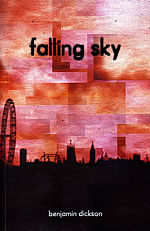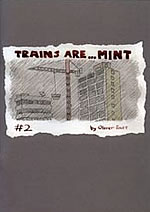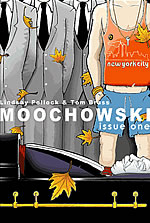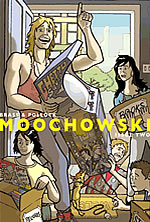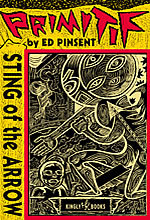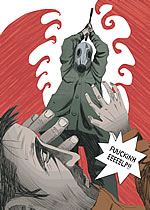Fast Fiction:
UK Small Press Reviews
It’s just over 25 years since I started the Fast Fiction table at the bi-monthly Westminster Central Hall Comic Marts, a stall and mail order service for ‘stripzines’ ably supported by Phil Elliott (who designed the first logos), Ian Wieczorek (who with Phil co-edited the first Fast Fiction anthologies), my schoolfriend the late Alan Gaulton (the all-important Morris Minor car-driver), and lastly Ed Pinsent (who shepherded the whole shebang with aplomb when Escape took over my time), vital contributors all.
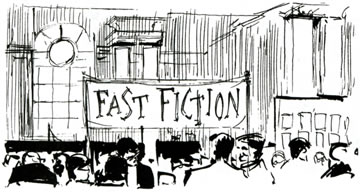
Alec: How To Be An Artist by Eddie Campbell
In 2007, in the era of digital printing and weblinks, Lulu and other print-on-demand outfits and MySpace, Bugpowder, Smallzone and Red Eye, the UK small press and self-published comix scenes are more bracingly varied and vigorous than ever - it’s even Faster, or Fastest Fiction now. Last Thursday, May 3rd 2007, I went to the opening of the Hayward Gallery Touring Exhibition Cult Fiction at the New Art Gallery, Walsall. Alongside the original art on show were a number of comics by British ‘artists’, from Olivia Plender‘s Masterpiece, James Pyman‘s Wilf: A Life In Pictures and 9 Panel Grid, and Adam Dant‘s Donald Parsnips to productions sent in for display, in response to an open call for submissions, such as David Blandy‘s Man From Elsewhere and Marc Ellerby‘s Venal Muse.
Ahead of next weekend’s plethora of hot-off-the-press releases at the Bristol Comics Expo, I’m going to spotlight just a few homegrown titles and plan to cover more on this site. Back in the relatively low-output days of photocopying the Fast Fiction Info Sheet, one bi-monthly double-sided A4 sheet folded in half to A5 with listings, covers and a mail order form, I never attempted lengthy commentaries, let alone much criticism, of new publications. Fortunately, these days review sites and blogs exist to cover some of the frenzied outpourings, but I hope this modest 21st century electronic version of the Fast Fiction Info Sheet can help bring a bit more deserved attention to our British Do-It-Yourself comix culture.
This notion has also been partly inspired by my visiting the third UK Web & Mini Comix Thing in Mile End, London, in March 2007 - abuzz with all manner of do-it-yourself comics, on paper and in pixels, and related figurines, T-shirts and spin-off products. Thanks to the web, more and more cartoonists, some only 10 years old or younger, can build up a direct two-way relationship with their readers while extracting, plugging, blogging or serialising their comics on their sites. While there’s a burgeoning dedicated audience of ‘stripsurfers’ hungry for web comix alone and quite content to read these exclusively on their computer screens, plenty more appreciate the high-touch pleasures of printed versions of comics from the internet. What’s emerged are models for one-person, cottage-industry microbusinesses that can sustain and support comics creators online so that they are no longer reliant on middlemen like publishers, distributors and retailers.
It’s a flourishing time for the UK small press, rekindling the spirit and community of the Fast Fiction days of the Eighties. Here are a few releases that caught my eye and my imagination, and might catch yours.
Falling Sky
by Ben Dickson
Scar Comics
£7.99
Triumphalist, unscientific propaganda movies like Deep Impact or Armageddon avoid the uncomfortable truth that if, or when, a huge asteroid is on a collision course for our planet, there’s currently nothing we can do to stop it. In Ben Dickson’s 80-page debut, the asteroid is 48 hours away from striking London and that awful truth is a strict secret except to a selfish elite, who will stop at nothing to silence one of their own when he is kidnapped and risks revealing all. A writer turned artist, Dickson arrives at a distinct visual style by adapting photos of cast, props and locations into a Tintin-esque clear line, overlaid with second-colour sepia washes and moody charcoal. Instead of leaving certain backgrounds blank, he fills many of his open, fuzzy-edged panels with swathes of loosely sketched ‘interference’ patterns and adds a soft glow around his characters’ contours, as if to suggest their turmoil and their vulnerability. Not unlike Raymond Briggs’ nuclear warning When The Wind Blows, Dickson focuses on the individual, human-scale effects of massive catastrophe to deliver a wake-up call to complacent politicians and media about our blunt non-survivability in the face of space-born disaster. Gripping, unpredictable, the story’s high concept already has Hollywood calling, but can they handle its realistic ending?
‘Paint It Black!’ No, not the Rolling Stones’ song, but one solution suggested by scientists on a recent TV doc. I asked Ben Dickson what he thought of this and other ideas for preventing an asteroid striking the Earth:
“Yeah I heard about something like that. When I was researching the book I found lots of ingenious ways of diverting an asteroid. My favourite was planting little rockets on the side that would fire a controlled burst, altering its course that way. It would only need to alter it by a few millimetres and that would be enough. Another quite cool one was to place solar sails on the side, catching the suns rays and using that to knock it off course. Painting an asteroid black, and indeed using the solar sails thing, sound to me far too haphazard to actually try for real, especially when the whole world is at stake. (Do you go up there with cans of paint?) In order to work I think they would only paint one side of it, but it just doesn’t sound reliable enough to me. I personally prefer the rocket idea - NASA have had plenty of experience with that kind of thing, and in a zero gravity environment would be guaranteed to have an effect as long as everything works.
“I read that they probably would actually try to use nukes, but would explode them right next to the asteroid rather than hitting it, altering the course that way - but whether it would work would depend entirely on what the asteroid is made of (the less dense the rock, the harder to divert), and there’s no real way to know that for sure until you get there. But currently that is considered the more reliable method, although nobody seems to have considered the dangers of what happens if one of the missiles fails on take-off.
“All of these methods would take several years preparation to work, not to mention the time it would take to get to the asteroid itself, and how far away it needs to be for the diversion to be enough. If it’s only a week away, there isn’t a hope in hell of diverting it enough to miss us. I don’t know if I’ll get the chance to explore all that in a sequel book, but you never know!”
You can read more about these various theories here on Ben’s website.
Trains Are… Mint #2
by Oliver East
Rolling Stock Press
£4.00
On The Road becomes On The Track as Oliver continues to tramp, traipse, stroll and slog from station to station, here a stretch of railway from Lostock to Horwich outside Manchester. He takes us along footpaths that peter out, over bridges (one of them billed as ‘sexy’), through retail and carpark wastelands, across sodden fields, to the edges of his two contradictory maps and beyond. In a mix of autobiography and psychogeography, Oliver uses a loose, unfussy ink line and washes of watercolour to illustrate a mix of confidential, opinionated travel diary and a survey of this England’s odd, sometimes offputting ‘ordinary’ modern towns. His narrative techniques vary from wordless sequences, for example as he hauls himself whistling along a fallen tree trunk to get over a dried riverbed, to more text-driven passages about a mysterious remote electricity substation or the dubious architectural charms of Chorley. It’s a unique use of comics, almost a time capsule of the unrecorded everyday provinces. Aptly, this review was written while I was gazing out of the Billericay to Liverpool Street train. 36 A5 pages, card stock cover, full colour, numbered edition of 500.
Moochowski #1 & 2
by Tom Brass & Lindsay Pollock
Moochowski Comic
£5.00
How well do any of us know our parents? Falling autumn leaves are a motif in the first two issues of this 20-part graphic novel, which opens in 1986 at the funeral of one Hermann Wexler, New York legal giant, moral crusader and, of course, dedicated father’. The title is the surname of the long-haired, laid-back, 36-year old ‘moocher’ discovered living in the late lawyer’s Long Beach residence pool-house. To the surprise, if not dismay, of his two sons, business partners and heirs, piles of photos, postcards and other evidence prove that the ‘whiter-than-white’ Wexler and this lucky Felix Moochowski were secretly lovers. Fearing a gay sex scandal that could ruin the family and the firm, pushier older son Earl forces younger brother George to take in Moochowski to his home with his wife and two kids, while the firm tries to dig up some dirt to discredit and dispose of this threat to their fortune and future. ‘A few days is all we need to nail this.’ It quickly becomes clear that Moochowski’s stay and effect on the Wexler clan is going to last much longer than anticipated.
On this tight collaboration, Tom Brass and Lindsay Pollock, friends since they met in 1999 in film school, co-write and co-draw, Lindsay inking Tom’s pencils. They adopt a black background for their pages and the gutters between the panels, suggesting a darkened cinema-screen setting. Operating on the complete opposite philosophy to Alex Toth’s ‘less is more’ dictum, they fill every panel with a surfeit of details, drawing everything down to the veins on the leaves, reflections on windows, people in distant apartments. filled with signage, adverts, broad satirical gags - like such pun-filled brand names as the ‘J’accuzi 5000’ bath, ‘Chippit & Butterfingers’ removal firm, ‘Stink-Away’ extractor fan or sympathy card with a ‘2 for 1 Mr Wipey Tissues’ offer. Which might explain why it took the best part of a year between the first issue and the second. I’m usually pretty wary of excess rendering, with exceptions like Will Elder or Joe Sacco, but this ‘maximalism’ does work surprisingly well, prolonging the pleasures of exploring each panel or returning to it later. I just worry that maintaining this overegged art style is going to mean this serial will need two decades to complete.
As well as the more obvious satire, there are some more subtle moments here, It was only on a second reading that I properly appreciated a sequence on the fourth page where a shadowy figure vanishes from the bough of a tree in the background, overlooking the funeral. I may be wrong, as it is so far unexplained, but it may have been Moochowski. One clue is in a sequence in the second issue where he persuades George and his wife to join him up in the treehouse George and his father built together and Moochowski takes a view with them of the city. It’s also here that a more sensitive, almost endearing side of their loose-cannon lodger emerges, albeit briefly, before a huge removal van unloads all of his possessions and his scrawny incontinent mutt Mr Sprinkles. Once characters and settings are set up, the signs are that Moochowski can offer more than a diverting culture-clash comedy of manners. Published in numbered editions of 100 copies at £5 each, with full colour covers and smart paper stock, this deserves a far wider readership.
Update: Tom Brass got back to me with this:
"Issue three is coming on very well, thank you. We’ve addressed some of the problems re: pacing, detail etc… as we too were very aware of the possability of turning out issue ten somwhere near our fortieth birthdays! We’ve got a really strong script for the third ish and are starting on the art very soon (after a few stylistic tweaks to simplify things a little). As to the identity of the guy up the tree… Well, you’ll just have to wait and see!"
Malcolm Magic: The Collected Edition
by Robin and Lawrence Etherington
Blink Twice Publications
£10.00
Chatting with artist Lorenzo (Lawrence) at last years Bristol Comic Expo, I was quietly stunned and heartened when he told me one of his biggest influences is Roy Wilson. Never heard of him? Wilson was perhaps Britain’s most influential children’s cartoonist in the Thirties and Forties. Los Bros Etherington bring back all his old-time, cheery zaniness and blend it with surreal modern comedy about the weird side-effects of bunny-boy boozer Malcolm after accidentally drinking a bottle of motor oil. Get in the ground floor with this trade of the first three issues, complete with all the colour covers and a free sketchbook supplement.
Primitif
by Ed Pinsent
Kingly Books
£6.00
Primitif is anything but primitive. ‘Magpie-fashion’, Britain’s Ed Pinsent borrows facets from various cultures, continents and ages and adapts them into a brand of potent myth-making, resonant with symbolism and meaning and uniquely his own. His mysterious, mud-masked warrior and tribal leader, short, tough, impulsive, has been absent from comics for too long, some 15 years, so it’s a delight to find not one, but two unseen tales in this double-covered book. Land Of The Dead dates from 1990-1, originally illustrated in rich coloured crayons and aimed at the French market. Sting Of The Arrow composed in 2003 shows Ed’s mature style in strong, strident graphics and dark, troubling themes. Avoiding world balloons, using captions and frames that appear carved from stone or wood, Pinsent taps into the primal storytelling urges that drove our ancestors.
The Dial And Other Stories
by Chris Reynolds
Kingly Books
£7.50
Imagine Edward Hopper’s paintings and Andrei Tarkovsky’s films transposed to a rural Wales occupied by benign aliens. Yet Chris Reynolds’ visions remain uniquely his own, gently sinister and insinuating.
There is a special slowness to Reynolds’ pacing of panels and prose, encouraging the reader to linger over his enigmatic words within their quivering caption boxes, akin to hearing a strange radio broadcast through the ether, and to pause within his shadowed images in their thick frames, like some measured panning shot in an old movie.
Reynolds has vivid memories of growing up in the Vale of Ffestiniog, once described by Bertrand Russell as “an apocalyptic vision of Paradise”. "When I was young, there were erected nearby two large, sinister-looking power stations, which turned out to be benign. I used to play with the children of the Director of the nuclear-powered one and received early education in such things as radioactive contamination, mushroom clouds, and the like. But the main local influence on the settings in my comics was the town of Blaenau Ffestiniog, where the slate mines are, an apocalyptic vision of another kind. In the early years of the last century, enormous slate tips were beginning to swamp some parts of the town and had already covered some small hamlets. I remember climbing up to the high viaduct that was at the top of the town with my friend, to explore the slate mines there, until we were chased away."
Reynolds identifies other influences in the smaller details in his comics. "Dry-stone walls are an ever-present feature, as are the terraces and lone houses of a certain local style. Also there are the chapels. When I was small, these seemed as big as the power stations, older, but just as sinister. Unfortunately, few are left now. They look their most bleakly magnificent in the mist and rain, shut up and dark on a weekday as life goes on around them."
Dead Man’s Shoes
by Anjan Sarkar
Warp Films
£12.99
Dead Man’s Shoes by Shane Meadows garnered rave reviews as the best Brit film of the year. It defies genres, reeling from the supernatural to working class comedy, from Death Wish-style thriller to social realism. Richard, a highly trained soldier, comes home from the army to protect his younger, slightly retarded brother. Together they set up camp in the hills above their rundown Midlands hometown, which is now ruled by a gang of drug dealers and thugs. Richard’s return instils paranoia and terror in the criminals’ minds, as they realise his mission is to take violent retribution against them. Starting from his storyboards for Meadows’ screenplay, artist Anjan Sarkar has crafted his own interpretation as an 88-page full colour graphic novel. While it differs slightly in places, his spin on the story is equally gripping and stands up in its own right as a bleak tragi-comedy about the love and guilt between brothers and the price of revenge. Ideal for movie and Preacher fans, Anjan’s unique re-mix and tie-in will be sold with the DVD but is out now separately.













